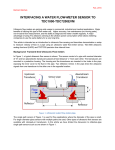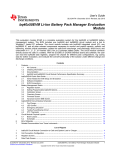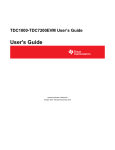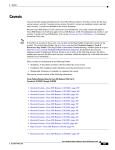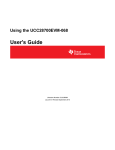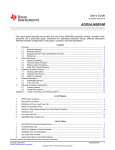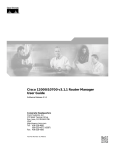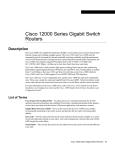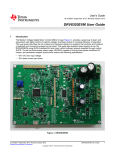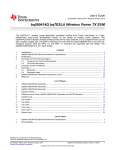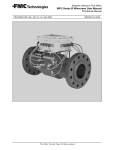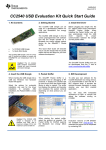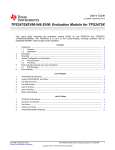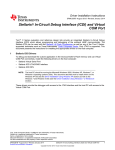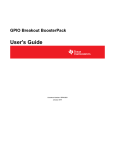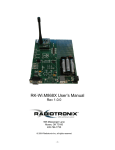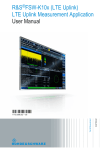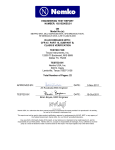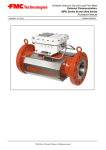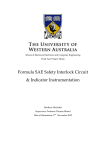Download snia020 - TI E2E Community
Transcript
User's Guide SNIA020 – March 2015 Interfacing a Water Flow-meter Sensor to TDC1000TDC7200EVM Ultrasonic flow-meters are gaining wide usage in commercial, industrial and medical applications. Major benefits of utilizing this type of flow meter are higher accuracy, low maintenance (no moving parts), noninvasive flow measurement, and the ability to diagnose the meter’s health regularly. A major advantage of using TI’s ultrasonic sensing is the ultra-low power consumption, which allows metering companies to use the same battery for a very long time. This article is intended as an introduction to ultrasonic flow sensing and describes a demonstration setup to measure velocity of flow in a pipe using an ultrasonic water flow-meter sensor, the TDC1000 ultrasonic analog-front-end (UAFE), and TDC7200 precision time interval timer. 1 2 3 4 5 6 7 8 9 10 11 12 Contents Background: Transient-time Ultrasonic Flow-meters .................................................................... 2 Measurement Sequence ................................................................................................... 2 Volumetric Flow Calculations............................................................................................... 3 Calculation of Volumetric Flow Rate, Q ................................................................................... 3 Zero Flow Measurement Setup ............................................................................................ 4 The Choice of the Ultrasonic Flow-meter Sensor ....................................................................... 5 Steps to Configure the Setup .............................................................................................. 7 GUI Configuration ........................................................................................................... 8 Observing the Waveform Using an Oscilloscope ...................................................................... 11 Displaying the Delta TOF in GUI’s GRAPH Menu ..................................................................... 13 Saving Data in a File ...................................................................................................... 14 Appendix 1: Sensor Manufacturer ....................................................................................... 15 List of Figures 1 Ultrasonic Water Flow-meter Pipe ......................................................................................... 2 2 Ultrasonic Signal Measurement Sequence. .............................................................................. 2 3 Zero Flow Measurement Setup ............................................................................................ 4 4 Zero Flow Demonstration Setup ........................................................................................... 5 5 Ultrasonic Flow-meter Sensor Pipe 6 7 8 9 10 11 12 13 ....................................................................................... 6 EVM Connections to the Sensor ........................................................................................... 7 TDC1000 Setup Menu in the GUI ......................................................................................... 8 Sampling Interval Setup..................................................................................................... 9 TDC7200 Registers Setup ................................................................................................ 10 Scope Trace TOF Measurement Sequence ............................................................................ 11 ΔTOF Measurement Sequence .......................................................................................... 12 ΔTOF Graph Display ....................................................................................................... 13 Sample Data Stored in a File ............................................................................................. 14 List of Tables 1 Waveform Observations Using an Oscilloscope ....................................................................... 11 2 Sensor Manufacturer....................................................................................................... 15 All trademarks are the property of their respective owners. SNIA020 – March 2015 Submit Documentation Feedback Interfacing a Water Flow-meter Sensor to TDC1000-TDC7200EVM Copyright © 2015, Texas Instruments Incorporated 1 Background: Transient-time Ultrasonic Flow-meters 1 www.ti.com Background: Transient-time Ultrasonic Flow-meters In Figure 1, a typical ultrasonic flow sensor is shown. The sensor consist of a pipe with nominal diameter of “D” and two piezoelectric transducers placed at fixed distance “L” from each other. The transducers are mounted in a protective housing. The housing and the transducers are inserted in the holes in the pipe, exposing the inner cover to the fluid in the pipe. Two reflection mirrors in the pipe direct the ultrasonic signals from one transducer to the other one in the opposite location. Figure 1. Ultrasonic Water Flow-meter Pipe The single path sensor of Figure 1 is used for flow applications where the diameter of the pipe is small. For larger diameter pipes, sensors with multiple paths are used. Other types of ultrasonic flow sensors are available with clamped-on transducers. In this article, the discussion will be limited to reflective-type single path sensors such as the one shown in Figure 1. 2 Measurement Sequence Referring to Figure 2, the measurement sequence starts by exciting one of the transducers, “A”, by applying a burst of given number of pulses (in Figure 2, three TX pulses) to the transducer. The frequency of excitation signal must be equal to the resonance frequency of the transducer. For water flow applications, transducers with resonant frequency of one to three MHz are used. Excitation TX START Receiver RX Qualifying threshold setting - mV tTOFt STOP Figure 2. Ultrasonic Signal Measurement Sequence. The transducer generates ultrasonic pressure pulses that are directed towards the second transducer, in this case B, by means of the reflectors in the pipe. At the same time that the first pulse is being applied to the transducer, a “START” signal is generated to mark the beginning of the “time-of-flight” measurement. 2 Interfacing a Water Flow-meter Sensor to TDC1000-TDC7200EVM Copyright © 2015, Texas Instruments Incorporated SNIA020 – March 2015 Submit Documentation Feedback Volumetric Flow Calculations www.ti.com On the receiver side, the electronic circuits in the path condition the received signal and generate a “STOP” pulse to mark the time the ultrasonic pulse is received at the other end. The time taken for the ultrasound wave to travel from one sensor to the other is referred as the “Time-Of-Flight” (TOF). A stop watch is needed to measure the time internal between the “START” and “STOP”, in this case TOFAB. The direction of the transmit/receive sequence is switched and next the TOFBA is measured. The difference between TOFAB and TOFBA is proportional to the velocity of the flow of the medium in the pipe. 3 Volumetric Flow Calculations The expressions for calculating the TOF between two transducers is given as: distance between the transducers TOF speed of sound Referring to Figure 1 , the expressions for TOF for downstream (TOFAB) and upstream (TOFBA) are: 1 L 1 TOFAB = l + + l C C+ V C 1 L 1 TOFBA = l + + l C C-V C (1) (2) where • • • l = D/2: D is the inner diameter of the pipe C = Speed of sound in the medium V = Average Velocity of the medium (fluid/gas) in the pipe (3) Rearranging the terms and solving for V: 'TOF L · §D L · §D ¨C CV¸¨C C V¸ © ¹ © ¹ L2 L2 CV CV (C V)L (C V)L C2 V 2 2 (4) (5) 2 ΔT (C - V ) = 2 * L * V Since C >> V: (C2 - V2) ~ C2 (6) ΔT * C2 = 2 * L * V (7) 'T C2 2L (8) And: V 4 Calculation of Volumetric Flow Rate, Q The relationship for calculate the volumetric flow rate is: The relationship for calculate the volumetric flow rate is: Q = K * V * A where • • • K = Pipe calibration factor depending on the sensor V = Average velocity though of the fluid in the pipe A = The cross-sectional area of the meter pipe (9) TDC 1000 uses a common approach known as “zero-crossing” method to generate the “START” and “STOP”. At low flow rates, the difference between TOFAB and TOFBA is very small, for this reason a highly accurate timer such as TDC7200 with picoseconds resolution is required. SNIA020 – March 2015 Submit Documentation Feedback Interfacing a Water Flow-meter Sensor to TDC1000-TDC7200EVM Copyright © 2015, Texas Instruments Incorporated 3 Zero Flow Measurement Setup 5 www.ti.com Zero Flow Measurement Setup In this document, we describe interfacing of TDC1000 and TDC7200 integrated circuits. The block diagram of the setup is shown in Figure 3. MSP430 microcontroller is used for programming of TDC1000 and TDC7200 and for communication with a host PC over USB interface. A Graphic User Interface (GUI) is used for programming the registers of TDC1000 and TDC7200 and for displaying ΔTOF at zero flow condition. TDC7200 MSP43XX OSC USB RTD1 TX2 RX1 RX2 TX1 TDC1000 RREF A TDC1000-TDC7200EVM STOP START TRIGGER SPI Host PC Running TDC1000-7200 GUI B RTD temp sensor Flow Ultrasonic flow sensor Figure 3. Zero Flow Measurement Setup 4 Interfacing a Water Flow-meter Sensor to TDC1000-TDC7200EVM Copyright © 2015, Texas Instruments Incorporated SNIA020 – March 2015 Submit Documentation Feedback The Choice of the Ultrasonic Flow-meter Sensor www.ti.com 6 The Choice of the Ultrasonic Flow-meter Sensor The zero-flow demonstration setup is shown in Figure 4. Ultrasonic flow sensor TDC1000TDC7200EVM GUI TDC1000TDC7200EVM Figure 4. Zero Flow Demonstration Setup System requirements, standards, and cost dictate the choice of flow-meter sensors. Water is a good medium for propagating ultrasonic pressure pulse and the most common sensors in this application have resonance frequency in the range of MHz, 1 MHz in this case. SNIA020 – March 2015 Submit Documentation Feedback Interfacing a Water Flow-meter Sensor to TDC1000-TDC7200EVM Copyright © 2015, Texas Instruments Incorporated 5 The Choice of the Ultrasonic Flow-meter Sensor www.ti.com For demonstration purposes, we use an Audiowell ultrasonic water flow-meter pipe shown in Figure 5. This sensor can be obtained from the source included in the reference section. Union & extension Ultrasonic flow sensor pipe End cap Ultrasonic transducer End cap Ultrasonic transducer RTD temperature sensor (PT1000) Figure 5. Ultrasonic Flow-meter Sensor Pipe 6 Interfacing a Water Flow-meter Sensor to TDC1000-TDC7200EVM Copyright © 2015, Texas Instruments Incorporated SNIA020 – March 2015 Submit Documentation Feedback Steps to Configure the Setup www.ti.com 7 Steps to Configure the Setup 1. Obtain a TDC1000-TDC7200EVM 2. Obtain the ultrasonic water flow sensor shown in Figure 5 from the source in the reference section of this document (Audiowell). The union and the pipe extension are not necessary for zero flow test but you would need the end caps to confine water in the pipe for the test. The RTD temperature senor is not included in the sensor and can be obtained from a different manufacturer. The RTD used in this setup is a JUMO PT1000. If you need to use a PT500 temperature senor, you would need to change the temp sensor reference resistor (RREF) on the TDC1000-TDC7200EVM to 500 Ω (the EVM board comes with a 1000-Ω resistor reference resistor). 3. Place a cap at one end of the sensor and fill the pipe with clean water. Make sure there are no bubbles trapped in the sensor. Place the second cap and the open end of the pipe to confine water inside the pipe. 4. Connect the sensor to the EVM connector as shown in Figure 6. Place the pipe on a flat surface in a standup position as shown in Figure 4. This would move up any bubbles trapped between the two transducers to the top of the pipe and away from the signal path. Bubbles trapped in the signal path cause severe attenuation of signal. 5. You may want to view the signal waveforms (Start, Stop, and Ultrasound received waveform at the input of TDC1000 internal comparators) on a scope to make sure proper operation of the sensor. You can either connect the scope probes to the provided terminals (test points) on the EVM or solder SMA connector on the EVM board and use the cables shown in Figure 4. Transducer (1) & (2) PT1000 temp sensor COMP_IN STOP START Scope Probe Terminals Figure 6. EVM Connections to the Sensor 6. Install the TDC1000-TDC7200EVM software per the instruction in the user’s manual 7. Connect the EVM to the Host PC using the provided USB cable SNIA020 – March 2015 Submit Documentation Feedback Interfacing a Water Flow-meter Sensor to TDC1000-TDC7200EVM Copyright © 2015, Texas Instruments Incorporated 7 GUI Configuration 8 www.ti.com GUI Configuration 1. Run the GUI; if prompted, upgrade the version of the EVM firmware per the instructions in the TDC1000-TDC7200EVM User’s Manual. 2. Set the registers in the TDC1000 menu to the values shown in Figure 7, Figure 8, and Figure 9. Flip the “CONTINOUS TRIGGER” switch to the top position (switch will turn to green from red indicating that the system is running). Divide by 8 8 pulses 1 Cycle 5 STOPS Enabled TOF Measurement Enabled Disabled PT1000 Mode 2 -125mV Single Echo 15 dB Active Bypass Flip to continuous trigger position 38 Disabled Divided by 1 Figure 7. TDC1000 Setup Menu in the GUI 8 Interfacing a Water Flow-meter Sensor to TDC1000-TDC7200EVM Copyright © 2015, Texas Instruments Incorporated SNIA020 – March 2015 Submit Documentation Feedback GUI Configuration www.ti.com ON BOARD OSC (8MHz) 1.0sec Figure 8. Sampling Interval Setup SNIA020 – March 2015 Submit Documentation Feedback Interfacing a Water Flow-meter Sensor to TDC1000-TDC7200EVM Copyright © 2015, Texas Instruments Incorporated 9 GUI Configuration www.ti.com Five Figure 9. TDC7200 Registers Setup 10 Interfacing a Water Flow-meter Sensor to TDC1000-TDC7200EVM Copyright © 2015, Texas Instruments Incorporated SNIA020 – March 2015 Submit Documentation Feedback Observing the Waveform Using an Oscilloscope www.ti.com 9 Observing the Waveform Using an Oscilloscope Table 1. Waveform Observations Using an Oscilloscope CH A START, 5 V/DIV CHAB STOP, 5 V/DIV CH C COMP_IN, 5V/DIV Trigger Normal, on Ch A , positive edge Time base 20 uV/DIV You should be able to get similar display on you scope screen as shown in Figure 10. The time of flight can be measured reference to STOP pulse one to five. When calculating the delta TOF, if the same STOP pulse is used to measure the TOF for upstream and downstream, the net effect is canceled out and the delta TOF is the same no matter what STOP pulse is used to measure The TOF. Figure 10. Scope Trace TOF Measurement Sequence SNIA020 – March 2015 Submit Documentation Feedback Interfacing a Water Flow-meter Sensor to TDC1000-TDC7200EVM Copyright © 2015, Texas Instruments Incorporated 11 Observing the Waveform Using an Oscilloscope www.ti.com Now change the time base of the scope to 200 uV/DIV, you should see the TX/RX sequence for both directions as shown in Figure 11. In mode 2 of TDC1000 operation if CH_SWP is enabled, the state machine upon receiving a trigger pulse will TX/RX in one direction, then switch the direction. Upon receiving a second trigger, it will TX/RX in the other direction. Figure 11. ΔTOF Measurement Sequence 12 Interfacing a Water Flow-meter Sensor to TDC1000-TDC7200EVM Copyright © 2015, Texas Instruments Incorporated SNIA020 – March 2015 Submit Documentation Feedback Displaying the Delta TOF in GUI’s GRAPH Menu www.ti.com 10 Displaying the Delta TOF in GUI’s GRAPH Menu Click on the “GRAPH” tab to display the “GRAPH” menu. In the box below “Flow MODE” on the right bottom corner of the display, check the flow mode option. In this mode, the GUI generates a downstream and upstream sequence, calculates the “Delta TOF”, and displays it at the top right of the screen under “FLOW DELTA AVG (ns)”. Under “TDC_SELECT”, chose the STOP pulse (STOP1, STOP2, etc.) that provides the best accuracy in calculating the TOF. Try different selection and observe the changes in delta TOF and STADEV. As mentioned in the previous section, as the TOF in the upstream and the downstream directions are measured in reference to the same STOP pulse, the net effect is independent of the choice of the STOP pulse. To start the graph, click on “START Graph” tab, you should see the yellow moving trace of the delta TOF versus time as shown in Figure 12. If the numbers in delta TOF and the STDEV boxes are changing but the graph is not being displayed (black screen) then the graph is out of scale. To force the graph to be displayed in the window, place the cursor on the black background and right-click your mouse. A drop window display will show up giving you the option to select auto scale in the X and Y axis. Once you check mark the auto scale box, the GUI will scale the graph to fit in the display window. Figure 12. ΔTOF Graph Display SNIA020 – March 2015 Submit Documentation Feedback Interfacing a Water Flow-meter Sensor to TDC1000-TDC7200EVM Copyright © 2015, Texas Instruments Incorporated 13 Saving Data in a File 11 www.ti.com Saving Data in a File To save data in a file for post processing purpose, check the box “SAVE GRAPH DATA TO FILE” before running the graph by clicking on “START GRAPH” button. You will be asked to name the file and identify a location in your computer to store the file. When you type in the information click the ok tab, you will be prompted to type the number of samples to be saved. If type ok without typing in the number of samples in the displayed box (0 samples by default), the GUI will continuously save unlimited number of data in the file until the “STOP GRAPH” tab is pressed to stop displaying the graph. The content of the file includes information as shown in Figure 13. TOF referenced to STOP1 pulse (ns) Delta TOF (nS) based on the STOP pulse selected in the ³7'&_6(/(&7´ER[. In this case START-STOP2 = B2 -B3 TOF downstream TOF downstream Figure 13. Sample Data Stored in a File 14 Interfacing a Water Flow-meter Sensor to TDC1000-TDC7200EVM Copyright © 2015, Texas Instruments Incorporated SNIA020 – March 2015 Submit Documentation Feedback Appendix 1: Sensor Manufacturer www.ti.com 12 Appendix 1: Sensor Manufacturer Table 2. Sensor Manufacturer APPLICATION MANUFACTURER P/N FR (kHz) Heat/water AudioWell: http://www.audiowell.com/en/product-detail.aspx?id=80 Brass Pipe For Heat meter DN25. Ultrasonic flow sensor AW5Y0980K04L193Z 1000 Heat/water AudioWell: http://www.audiowell.com/en/product-detail.aspx?id=80 Brass Pipe For Heat meter DN20. Ultrasonic flow sensor AW5Y0980K08L151Z 1000 SNIA020 – March 2015 Submit Documentation Feedback Interfacing a Water Flow-meter Sensor to TDC1000-TDC7200EVM Copyright © 2015, Texas Instruments Incorporated 15 STANDARD TERMS AND CONDITIONS FOR EVALUATION MODULES 1. Delivery: TI delivers TI evaluation boards, kits, or modules, including any accompanying demonstration software, components, or documentation (collectively, an “EVM” or “EVMs”) to the User (“User”) in accordance with the terms and conditions set forth herein. Acceptance of the EVM is expressly subject to the following terms and conditions. 1.1 EVMs are intended solely for product or software developers for use in a research and development setting to facilitate feasibility evaluation, experimentation, or scientific analysis of TI semiconductors products. EVMs have no direct function and are not finished products. EVMs shall not be directly or indirectly assembled as a part or subassembly in any finished product. For clarification, any software or software tools provided with the EVM (“Software”) shall not be subject to the terms and conditions set forth herein but rather shall be subject to the applicable terms and conditions that accompany such Software 1.2 EVMs are not intended for consumer or household use. EVMs may not be sold, sublicensed, leased, rented, loaned, assigned, or otherwise distributed for commercial purposes by Users, in whole or in part, or used in any finished product or production system. 2 Limited Warranty and Related Remedies/Disclaimers: 2.1 These terms and conditions do not apply to Software. The warranty, if any, for Software is covered in the applicable Software License Agreement. 2.2 TI warrants that the TI EVM will conform to TI's published specifications for ninety (90) days after the date TI delivers such EVM to User. Notwithstanding the foregoing, TI shall not be liable for any defects that are caused by neglect, misuse or mistreatment by an entity other than TI, including improper installation or testing, or for any EVMs that have been altered or modified in any way by an entity other than TI. Moreover, TI shall not be liable for any defects that result from User's design, specifications or instructions for such EVMs. Testing and other quality control techniques are used to the extent TI deems necessary or as mandated by government requirements. TI does not test all parameters of each EVM. 2.3 If any EVM fails to conform to the warranty set forth above, TI's sole liability shall be at its option to repair or replace such EVM, or credit User's account for such EVM. TI's liability under this warranty shall be limited to EVMs that are returned during the warranty period to the address designated by TI and that are determined by TI not to conform to such warranty. If TI elects to repair or replace such EVM, TI shall have a reasonable time to repair such EVM or provide replacements. Repaired EVMs shall be warranted for the remainder of the original warranty period. Replaced EVMs shall be warranted for a new full ninety (90) day warranty period. 3 Regulatory Notices: 3.1 United States 3.1.1 Notice applicable to EVMs not FCC-Approved: This kit is designed to allow product developers to evaluate electronic components, circuitry, or software associated with the kit to determine whether to incorporate such items in a finished product and software developers to write software applications for use with the end product. This kit is not a finished product and when assembled may not be resold or otherwise marketed unless all required FCC equipment authorizations are first obtained. Operation is subject to the condition that this product not cause harmful interference to licensed radio stations and that this product accept harmful interference. Unless the assembled kit is designed to operate under part 15, part 18 or part 95 of this chapter, the operator of the kit must operate under the authority of an FCC license holder or must secure an experimental authorization under part 5 of this chapter. 3.1.2 For EVMs annotated as FCC – FEDERAL COMMUNICATIONS COMMISSION Part 15 Compliant: CAUTION This device complies with part 15 of the FCC Rules. Operation is subject to the following two conditions: (1) This device may not cause harmful interference, and (2) this device must accept any interference received, including interference that may cause undesired operation. Changes or modifications not expressly approved by the party responsible for compliance could void the user's authority to operate the equipment. FCC Interference Statement for Class A EVM devices NOTE: This equipment has been tested and found to comply with the limits for a Class A digital device, pursuant to part 15 of the FCC Rules. These limits are designed to provide reasonable protection against harmful interference when the equipment is operated in a commercial environment. This equipment generates, uses, and can radiate radio frequency energy and, if not installed and used in accordance with the instruction manual, may cause harmful interference to radio communications. Operation of this equipment in a residential area is likely to cause harmful interference in which case the user will be required to correct the interference at his own expense. SPACER SPACER SPACER SPACER SPACER SPACER SPACER SPACER FCC Interference Statement for Class B EVM devices NOTE: This equipment has been tested and found to comply with the limits for a Class B digital device, pursuant to part 15 of the FCC Rules. These limits are designed to provide reasonable protection against harmful interference in a residential installation. This equipment generates, uses and can radiate radio frequency energy and, if not installed and used in accordance with the instructions, may cause harmful interference to radio communications. However, there is no guarantee that interference will not occur in a particular installation. If this equipment does cause harmful interference to radio or television reception, which can be determined by turning the equipment off and on, the user is encouraged to try to correct the interference by one or more of the following measures: • • • • Reorient or relocate the receiving antenna. Increase the separation between the equipment and receiver. Connect the equipment into an outlet on a circuit different from that to which the receiver is connected. Consult the dealer or an experienced radio/TV technician for help. 3.2 Canada 3.2.1 For EVMs issued with an Industry Canada Certificate of Conformance to RSS-210 Concerning EVMs Including Radio Transmitters: This device complies with Industry Canada license-exempt RSS standard(s). Operation is subject to the following two conditions: (1) this device may not cause interference, and (2) this device must accept any interference, including interference that may cause undesired operation of the device. Concernant les EVMs avec appareils radio: Le présent appareil est conforme aux CNR d'Industrie Canada applicables aux appareils radio exempts de licence. L'exploitation est autorisée aux deux conditions suivantes: (1) l'appareil ne doit pas produire de brouillage, et (2) l'utilisateur de l'appareil doit accepter tout brouillage radioélectrique subi, même si le brouillage est susceptible d'en compromettre le fonctionnement. Concerning EVMs Including Detachable Antennas: Under Industry Canada regulations, this radio transmitter may only operate using an antenna of a type and maximum (or lesser) gain approved for the transmitter by Industry Canada. To reduce potential radio interference to other users, the antenna type and its gain should be so chosen that the equivalent isotropically radiated power (e.i.r.p.) is not more than that necessary for successful communication. This radio transmitter has been approved by Industry Canada to operate with the antenna types listed in the user guide with the maximum permissible gain and required antenna impedance for each antenna type indicated. Antenna types not included in this list, having a gain greater than the maximum gain indicated for that type, are strictly prohibited for use with this device. Concernant les EVMs avec antennes détachables Conformément à la réglementation d'Industrie Canada, le présent émetteur radio peut fonctionner avec une antenne d'un type et d'un gain maximal (ou inférieur) approuvé pour l'émetteur par Industrie Canada. Dans le but de réduire les risques de brouillage radioélectrique à l'intention des autres utilisateurs, il faut choisir le type d'antenne et son gain de sorte que la puissance isotrope rayonnée équivalente (p.i.r.e.) ne dépasse pas l'intensité nécessaire à l'établissement d'une communication satisfaisante. Le présent émetteur radio a été approuvé par Industrie Canada pour fonctionner avec les types d'antenne énumérés dans le manuel d’usage et ayant un gain admissible maximal et l'impédance requise pour chaque type d'antenne. Les types d'antenne non inclus dans cette liste, ou dont le gain est supérieur au gain maximal indiqué, sont strictement interdits pour l'exploitation de l'émetteur 3.3 Japan 3.3.1 Notice for EVMs delivered in Japan: Please see http://www.tij.co.jp/lsds/ti_ja/general/eStore/notice_01.page 日本国内に 輸入される評価用キット、ボードについては、次のところをご覧ください。 http://www.tij.co.jp/lsds/ti_ja/general/eStore/notice_01.page 3.3.2 Notice for Users of EVMs Considered “Radio Frequency Products” in Japan: EVMs entering Japan may not be certified by TI as conforming to Technical Regulations of Radio Law of Japan. If User uses EVMs in Japan, not certified to Technical Regulations of Radio Law of Japan, User is required by Radio Law of Japan to follow the instructions below with respect to EVMs: 1. 2. 3. Use EVMs in a shielded room or any other test facility as defined in the notification #173 issued by Ministry of Internal Affairs and Communications on March 28, 2006, based on Sub-section 1.1 of Article 6 of the Ministry’s Rule for Enforcement of Radio Law of Japan, Use EVMs only after User obtains the license of Test Radio Station as provided in Radio Law of Japan with respect to EVMs, or Use of EVMs only after User obtains the Technical Regulations Conformity Certification as provided in Radio Law of Japan with respect to EVMs. Also, do not transfer EVMs, unless User gives the same notice above to the transferee. Please note that if User does not follow the instructions above, User will be subject to penalties of Radio Law of Japan. SPACER SPACER SPACER SPACER SPACER 【無線電波を送信する製品の開発キットをお使いになる際の注意事項】 開発キットの中には技術基準適合証明を受けて いないものがあります。 技術適合証明を受けていないもののご使用に際しては、電波法遵守のため、以下のいずれかの 措置を取っていただく必要がありますのでご注意ください。 1. 2. 3. 電波法施行規則第6条第1項第1号に基づく平成18年3月28日総務省告示第173号で定められた電波暗室等の試験設備でご使用 いただく。 実験局の免許を取得後ご使用いただく。 技術基準適合証明を取得後ご使用いただく。 なお、本製品は、上記の「ご使用にあたっての注意」を譲渡先、移転先に通知しない限り、譲渡、移転できないものとします。 上記を遵守頂けない場合は、電波法の罰則が適用される可能性があることをご留意ください。 日本テキサス・イ ンスツルメンツ株式会社 東京都新宿区西新宿6丁目24番1号 西新宿三井ビル 3.3.3 Notice for EVMs for Power Line Communication: Please see http://www.tij.co.jp/lsds/ti_ja/general/eStore/notice_02.page 電力線搬送波通信についての開発キットをお使いになる際の注意事項については、次のところをご覧くださ い。http://www.tij.co.jp/lsds/ti_ja/general/eStore/notice_02.page SPACER 4 EVM Use Restrictions and Warnings: 4.1 EVMS ARE NOT FOR USE IN FUNCTIONAL SAFETY AND/OR SAFETY CRITICAL EVALUATIONS, INCLUDING BUT NOT LIMITED TO EVALUATIONS OF LIFE SUPPORT APPLICATIONS. 4.2 User must read and apply the user guide and other available documentation provided by TI regarding the EVM prior to handling or using the EVM, including without limitation any warning or restriction notices. The notices contain important safety information related to, for example, temperatures and voltages. 4.3 Safety-Related Warnings and Restrictions: 4.3.1 User shall operate the EVM within TI’s recommended specifications and environmental considerations stated in the user guide, other available documentation provided by TI, and any other applicable requirements and employ reasonable and customary safeguards. Exceeding the specified performance ratings and specifications (including but not limited to input and output voltage, current, power, and environmental ranges) for the EVM may cause personal injury or death, or property damage. If there are questions concerning performance ratings and specifications, User should contact a TI field representative prior to connecting interface electronics including input power and intended loads. Any loads applied outside of the specified output range may also result in unintended and/or inaccurate operation and/or possible permanent damage to the EVM and/or interface electronics. Please consult the EVM user guide prior to connecting any load to the EVM output. If there is uncertainty as to the load specification, please contact a TI field representative. During normal operation, even with the inputs and outputs kept within the specified allowable ranges, some circuit components may have elevated case temperatures. These components include but are not limited to linear regulators, switching transistors, pass transistors, current sense resistors, and heat sinks, which can be identified using the information in the associated documentation. When working with the EVM, please be aware that the EVM may become very warm. 4.3.2 EVMs are intended solely for use by technically qualified, professional electronics experts who are familiar with the dangers and application risks associated with handling electrical mechanical components, systems, and subsystems. User assumes all responsibility and liability for proper and safe handling and use of the EVM by User or its employees, affiliates, contractors or designees. User assumes all responsibility and liability to ensure that any interfaces (electronic and/or mechanical) between the EVM and any human body are designed with suitable isolation and means to safely limit accessible leakage currents to minimize the risk of electrical shock hazard. User assumes all responsibility and liability for any improper or unsafe handling or use of the EVM by User or its employees, affiliates, contractors or designees. 4.4 User assumes all responsibility and liability to determine whether the EVM is subject to any applicable international, federal, state, or local laws and regulations related to User’s handling and use of the EVM and, if applicable, User assumes all responsibility and liability for compliance in all respects with such laws and regulations. User assumes all responsibility and liability for proper disposal and recycling of the EVM consistent with all applicable international, federal, state, and local requirements. 5. Accuracy of Information: To the extent TI provides information on the availability and function of EVMs, TI attempts to be as accurate as possible. However, TI does not warrant the accuracy of EVM descriptions, EVM availability or other information on its websites as accurate, complete, reliable, current, or error-free. SPACER SPACER SPACER SPACER SPACER SPACER SPACER 6. Disclaimers: 6.1 EXCEPT AS SET FORTH ABOVE, EVMS AND ANY WRITTEN DESIGN MATERIALS PROVIDED WITH THE EVM (AND THE DESIGN OF THE EVM ITSELF) ARE PROVIDED "AS IS" AND "WITH ALL FAULTS." TI DISCLAIMS ALL OTHER WARRANTIES, EXPRESS OR IMPLIED, REGARDING SUCH ITEMS, INCLUDING BUT NOT LIMITED TO ANY IMPLIED WARRANTIES OF MERCHANTABILITY OR FITNESS FOR A PARTICULAR PURPOSE OR NON-INFRINGEMENT OF ANY THIRD PARTY PATENTS, COPYRIGHTS, TRADE SECRETS OR OTHER INTELLECTUAL PROPERTY RIGHTS. 6.2 EXCEPT FOR THE LIMITED RIGHT TO USE THE EVM SET FORTH HEREIN, NOTHING IN THESE TERMS AND CONDITIONS SHALL BE CONSTRUED AS GRANTING OR CONFERRING ANY RIGHTS BY LICENSE, PATENT, OR ANY OTHER INDUSTRIAL OR INTELLECTUAL PROPERTY RIGHT OF TI, ITS SUPPLIERS/LICENSORS OR ANY OTHER THIRD PARTY, TO USE THE EVM IN ANY FINISHED END-USER OR READY-TO-USE FINAL PRODUCT, OR FOR ANY INVENTION, DISCOVERY OR IMPROVEMENT MADE, CONCEIVED OR ACQUIRED PRIOR TO OR AFTER DELIVERY OF THE EVM. 7. USER'S INDEMNITY OBLIGATIONS AND REPRESENTATIONS. USER WILL DEFEND, INDEMNIFY AND HOLD TI, ITS LICENSORS AND THEIR REPRESENTATIVES HARMLESS FROM AND AGAINST ANY AND ALL CLAIMS, DAMAGES, LOSSES, EXPENSES, COSTS AND LIABILITIES (COLLECTIVELY, "CLAIMS") ARISING OUT OF OR IN CONNECTION WITH ANY HANDLING OR USE OF THE EVM THAT IS NOT IN ACCORDANCE WITH THESE TERMS AND CONDITIONS. THIS OBLIGATION SHALL APPLY WHETHER CLAIMS ARISE UNDER STATUTE, REGULATION, OR THE LAW OF TORT, CONTRACT OR ANY OTHER LEGAL THEORY, AND EVEN IF THE EVM FAILS TO PERFORM AS DESCRIBED OR EXPECTED. 8. Limitations on Damages and Liability: 8.1 General Limitations. IN NO EVENT SHALL TI BE LIABLE FOR ANY SPECIAL, COLLATERAL, INDIRECT, PUNITIVE, INCIDENTAL, CONSEQUENTIAL, OR EXEMPLARY DAMAGES IN CONNECTION WITH OR ARISING OUT OF THESE TERMS ANDCONDITIONS OR THE USE OF THE EVMS PROVIDED HEREUNDER, REGARDLESS OF WHETHER TI HAS BEEN ADVISED OF THE POSSIBILITY OF SUCH DAMAGES. EXCLUDED DAMAGES INCLUDE, BUT ARE NOT LIMITED TO, COST OF REMOVAL OR REINSTALLATION, ANCILLARY COSTS TO THE PROCUREMENT OF SUBSTITUTE GOODS OR SERVICES, RETESTING, OUTSIDE COMPUTER TIME, LABOR COSTS, LOSS OF GOODWILL, LOSS OF PROFITS, LOSS OF SAVINGS, LOSS OF USE, LOSS OF DATA, OR BUSINESS INTERRUPTION. NO CLAIM, SUIT OR ACTION SHALL BE BROUGHT AGAINST TI MORE THAN ONE YEAR AFTER THE RELATED CAUSE OF ACTION HAS OCCURRED. 8.2 Specific Limitations. IN NO EVENT SHALL TI'S AGGREGATE LIABILITY FROM ANY WARRANTY OR OTHER OBLIGATION ARISING OUT OF OR IN CONNECTION WITH THESE TERMS AND CONDITIONS, OR ANY USE OF ANY TI EVM PROVIDED HEREUNDER, EXCEED THE TOTAL AMOUNT PAID TO TI FOR THE PARTICULAR UNITS SOLD UNDER THESE TERMS AND CONDITIONS WITH RESPECT TO WHICH LOSSES OR DAMAGES ARE CLAIMED. THE EXISTENCE OF MORE THAN ONE CLAIM AGAINST THE PARTICULAR UNITS SOLD TO USER UNDER THESE TERMS AND CONDITIONS SHALL NOT ENLARGE OR EXTEND THIS LIMIT. 9. Return Policy. Except as otherwise provided, TI does not offer any refunds, returns, or exchanges. Furthermore, no return of EVM(s) will be accepted if the package has been opened and no return of the EVM(s) will be accepted if they are damaged or otherwise not in a resalable condition. If User feels it has been incorrectly charged for the EVM(s) it ordered or that delivery violates the applicable order, User should contact TI. All refunds will be made in full within thirty (30) working days from the return of the components(s), excluding any postage or packaging costs. 10. Governing Law: These terms and conditions shall be governed by and interpreted in accordance with the laws of the State of Texas, without reference to conflict-of-laws principles. User agrees that non-exclusive jurisdiction for any dispute arising out of or relating to these terms and conditions lies within courts located in the State of Texas and consents to venue in Dallas County, Texas. Notwithstanding the foregoing, any judgment may be enforced in any United States or foreign court, and TI may seek injunctive relief in any United States or foreign court. Mailing Address: Texas Instruments, Post Office Box 655303, Dallas, Texas 75265 Copyright © 2015, Texas Instruments Incorporated spacer IMPORTANT NOTICE Texas Instruments Incorporated and its subsidiaries (TI) reserve the right to make corrections, enhancements, improvements and other changes to its semiconductor products and services per JESD46, latest issue, and to discontinue any product or service per JESD48, latest issue. Buyers should obtain the latest relevant information before placing orders and should verify that such information is current and complete. All semiconductor products (also referred to herein as “components”) are sold subject to TI’s terms and conditions of sale supplied at the time of order acknowledgment. TI warrants performance of its components to the specifications applicable at the time of sale, in accordance with the warranty in TI’s terms and conditions of sale of semiconductor products. Testing and other quality control techniques are used to the extent TI deems necessary to support this warranty. Except where mandated by applicable law, testing of all parameters of each component is not necessarily performed. TI assumes no liability for applications assistance or the design of Buyers’ products. Buyers are responsible for their products and applications using TI components. To minimize the risks associated with Buyers’ products and applications, Buyers should provide adequate design and operating safeguards. TI does not warrant or represent that any license, either express or implied, is granted under any patent right, copyright, mask work right, or other intellectual property right relating to any combination, machine, or process in which TI components or services are used. Information published by TI regarding third-party products or services does not constitute a license to use such products or services or a warranty or endorsement thereof. Use of such information may require a license from a third party under the patents or other intellectual property of the third party, or a license from TI under the patents or other intellectual property of TI. Reproduction of significant portions of TI information in TI data books or data sheets is permissible only if reproduction is without alteration and is accompanied by all associated warranties, conditions, limitations, and notices. TI is not responsible or liable for such altered documentation. Information of third parties may be subject to additional restrictions. Resale of TI components or services with statements different from or beyond the parameters stated by TI for that component or service voids all express and any implied warranties for the associated TI component or service and is an unfair and deceptive business practice. TI is not responsible or liable for any such statements. Buyer acknowledges and agrees that it is solely responsible for compliance with all legal, regulatory and safety-related requirements concerning its products, and any use of TI components in its applications, notwithstanding any applications-related information or support that may be provided by TI. Buyer represents and agrees that it has all the necessary expertise to create and implement safeguards which anticipate dangerous consequences of failures, monitor failures and their consequences, lessen the likelihood of failures that might cause harm and take appropriate remedial actions. Buyer will fully indemnify TI and its representatives against any damages arising out of the use of any TI components in safety-critical applications. In some cases, TI components may be promoted specifically to facilitate safety-related applications. With such components, TI’s goal is to help enable customers to design and create their own end-product solutions that meet applicable functional safety standards and requirements. Nonetheless, such components are subject to these terms. No TI components are authorized for use in FDA Class III (or similar life-critical medical equipment) unless authorized officers of the parties have executed a special agreement specifically governing such use. Only those TI components which TI has specifically designated as military grade or “enhanced plastic” are designed and intended for use in military/aerospace applications or environments. Buyer acknowledges and agrees that any military or aerospace use of TI components which have not been so designated is solely at the Buyer's risk, and that Buyer is solely responsible for compliance with all legal and regulatory requirements in connection with such use. TI has specifically designated certain components as meeting ISO/TS16949 requirements, mainly for automotive use. In any case of use of non-designated products, TI will not be responsible for any failure to meet ISO/TS16949. Products Applications Audio www.ti.com/audio Automotive and Transportation www.ti.com/automotive Amplifiers amplifier.ti.com Communications and Telecom www.ti.com/communications Data Converters dataconverter.ti.com Computers and Peripherals www.ti.com/computers DLP® Products www.dlp.com Consumer Electronics www.ti.com/consumer-apps DSP dsp.ti.com Energy and Lighting www.ti.com/energy Clocks and Timers www.ti.com/clocks Industrial www.ti.com/industrial Interface interface.ti.com Medical www.ti.com/medical Logic logic.ti.com Security www.ti.com/security Power Mgmt power.ti.com Space, Avionics and Defense www.ti.com/space-avionics-defense Microcontrollers microcontroller.ti.com Video and Imaging www.ti.com/video RFID www.ti-rfid.com OMAP Applications Processors www.ti.com/omap TI E2E Community e2e.ti.com Wireless Connectivity www.ti.com/wirelessconnectivity Mailing Address: Texas Instruments, Post Office Box 655303, Dallas, Texas 75265 Copyright © 2015, Texas Instruments Incorporated




















